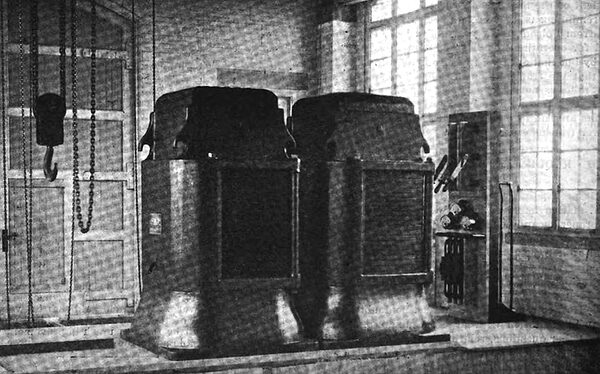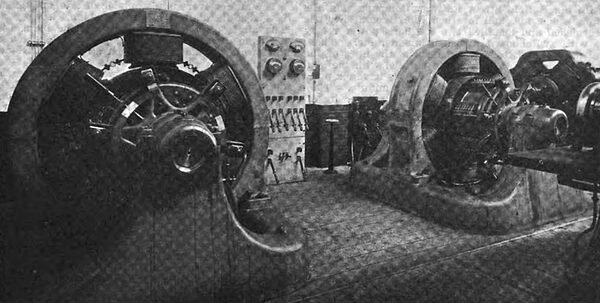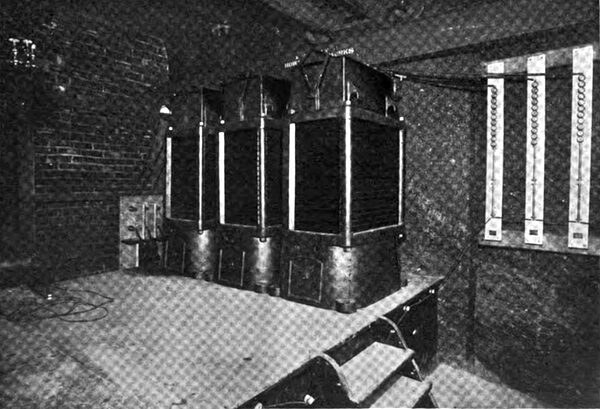[Trade Journal]
Publication: The Electrical Engineer
New York, NY, United States
vol. 22, no. 447, p. 540-542, col. 1-2
POWER TRANSMISSION.
INAUGURATION OF THE NIAGARA-BUFFALO POWER TRANSMISSION.
BY ORRIN E. DUNLAP.
THE greatest event in the history of the power development at Niagara Falls occurred at 12:01 o'clock on the morn of Monday, November 16, when Mr. William B. Rankine, secretary of the Niagara Falls Power Company, threw the switch that sent a portion of the power from one of the huge genera tors into the transformer house, adjoining the power station, where it was passed through transformers and transmitted to Buffalo. A few minutes before midnight Secretary Rankine, William A. Brackenridge, M. Am. Soc. C. E., chief engineer of the Cataract Construction Company, and Paul M. Lincoln, electrical superintendent of the Niagara Falls Power Company, mounted the switchboard platform, and at one minute after the power into the transformer house, where Mr. J. R. Edmonds, the Niagara Falls representative of the General Electric Company, was on duty. He closed the high tension switches and connected the transformers to the line. The low tension switch was thrown and the current passed into the transformers and out over the line to Buffalo. Everything was found to be in perfect working order. At the Buffalo end of the line, in the Buffalo Street Railway Company's plant, were gathered Mr. W. L. R. Emmet and Thomas H. Fearey, of the General Electric Company; George Urban, Jr., president of the Cataract Power and Conduit Company; Edgar B. Jewett, mayor of Buffalo; H. H. Littell, general manager of the Buffalo Street Railway Company, C. R. Huntley and other men prominent in the affairs of that city. The Niagara Falls Power Company's contract with the Buffalo Street Railway Company calls for the delivery of 1,000 horse-power at $36 per horse-power per annum. This power will be taken from the bus-bars into which the big generators feed in the power house.
In connection with this installation it may be stated that the General Electric Company entered into three separate contracts, and therefore three separate companies are interested in the apparatus installed. The first contract was made with the Cataract Construction Company. This was for three air blast transformers, blower motor, switchboards, etc. Each of these transformers is of 1,250 horse-power capacity, and any two of them can be used to transform 2,500 horse-power delivered to them in two-phase currents at 2,200 volts to three-phase currents at either 11,000 to 22,000 volts. In these transformers the coil connections are so arranged that the change in the voltage from 11,000 to 22,000 can be easily effected. Both the primary and secondary connection of the transformers lead to a switchboard. The low tension board is fitted with switches and fuses, while the high tension board is fitted with switches, fuses and current indicators.
Under their contract with the Cataract Construction Company the General Electric Company have installed the trans formers with all cables, connections, etc., from the generators in the power house to the transmission line. Lightning arresters have been placed in a small building on the south side of the transformer house at the point where the cables leave the building. The third transformer furnished under this contract is held in reserve. The design adopted for the Niagara installation is such that it can be extended until the full capacity of the transformer house is reached. The transformers are each 7 feet 10 inches high, and measure 5 feet 4 inches by 4 feet 8 inches at the base. Each weighs about 25, 000 pounds.
| |||
| General Electric Step-Up Static Transformers in Niagara Power House. |
The two transformers now in place stand at the eastern end of the transformer room and are supported on an iron frame work, their bases being 8 feet below the floor of the transformer house. The space below them is practically an air tight enclosure through which all connections to the transformers are made. In the pit below the transformers there is ample room for walking about, all conductors and connections being supported on large porcelain insulators and iron brackets. The connections to the transformers are made so that they can be detached without much trouble, and at any time when it is found advisable to substitute the extra transformer for one of those now in service, these connections will be opened and the transformers changed with the aid of a crane.
In the southeast corner of the transformer room stands a large centrifugal blower which is driven by a 5 horse-power electric motor, which stands close beside it. This blower de livers air to the enclosure below the transformers, from which point the air passes upward through spaces provided between the coils, and also by a separate space, provided between the laminations of the iron. The amount of air delivered in each of these places is controllable by valves, so that the temperature can be suitably adjusted with the minimum load on the blower motor. The arrangement of coils in these transformers is such that very strong insulation will have to be punctured before connection can be made between the different coils, or between the coils and the iron. At the same time the air spaces are so placed that the air is brought intimately in contact with each coil and gives an excellent cooling effect. This method of cooling makes necessary the occupation of a good deal of space in insulation and air, which has a tendency to increase the size of each transformer. Still, it is very a parent that it has the very great advantage of making the transformer clean and accessible, and much more convenient to handle than a transformer cooled by other methods.
The second contract the General Electric Company entered into in connection with the Niagara-Buffalo transmission was with the Cataract Power and Conduit Company, of Buffalo. This company was incorporated July 17, 1896, with George Urban, Jr., as president, and they will be the distributing agents of Niagara power in the city of Buffalo. Among others interested in this last named company are William B. Rankine, D. Ogden Mills, John Jacob Astor, Edward D. Adams, Francis Lynde Stetson, E. A. Wickes and Daniel O'Day. Their contract with the General Electric Co. called for four 265 k. w., or 360 horse-power transformers to be used in reducing the current from the line to a voltage suitable for connection to 500-volt rotary converters. These transformers are installed in a special building connected with the Buffalo Street Railway Company's power house. Their general construction and the method of cooling employed is very similar to that used with the large transformers at the Niagara Falls end of the line, described above. This building is also provided with switch board and lightning arresters. The "step down" transformers are each 6 feet 10 inches high, measure 3 feet 11 inches by 3 feet at the base, and weigh about 7,000 pounds each.
| |||
| The General Electric Rotary Converters in Power House of Buffalo Street Railway Co. |
| |||
| Interior of Step-Down Transformation Room, Rear of Niagara Street Station, Buffalo Ry. Co. |
It was with the Buffalo Street Railway Company that the third contract was made, and for them the General Electric Company furnished and installed two 500 horse-power rotary converters, with switchboard and instruments, etc. These rotaries will be operated to supply current to the lines of the Buffalo Street Railway Company, or in parallel with the generators now in their power house. The rotaries have six poles and operate at a speed of 500 revolutions per minute. They can be started either from the alternating current or by direct current from the lines to which they are attached.
It is significant of the enterprise of the Niagara Falls Power Company that they have built this transmission line and transmitted Niagara power to Buffalo at this early date, when their Buffalo franchise simply demands that they shall be prepared to sell power in that city on June 1, 1897. The erection of the line in the short period that has elapsed since it was started is work most creditable to all who had contracts. Especially is this true of the work of the White-Crosby Company, who built the pole line, and the General Electric Company.
At present three styles of insulators are on the line. The most noticeable of these, however, is the Niagara type, made by the Imperial Porcelain Works, of Trenton, N. J. The poles used in the construction of the line were furnished by Thomas Barnard, of Lockport, whose men cut about 1,500 of them on the Indian Peninsula, Georgian Bay, while about 1,300 of them were obtained at various points along the Canadian Pacific Railway.
The lightning arresters are of the Wirt type, single pole, and consist of marble upon which are mounted eleven cylinders giving one air gap space 1-32 in. for each one thou sand volts with an allowance of 25 per cent., rise in the potential. In the action of the arrester the large metal cylinders serve to chill the arc so that on reversal of the current the arc is extinguished, no dependence being placed upon any non-arcing property of the metal to put out the arc. In order to limit the current on short circuit and thus the heating effect, a special solid graphite rod of low non-inductive resistance is used. The arresters are similar to those used on the Big Cottonwood transmission at Salt Lake City, described lately in The Electrical Engineer, which have effectually protected the machinery in many severe storms.
The first power sent to Buffalo was at a voltage of 11,000, and now that the line is in successful operation, it is probable that the news will soon come that Buffalo is prepared to use more power. The Buffalo franchise calls for the delivery of 10,000 horse-power there by June 1, 1897, should there be a demand for it, and also that the power company shall be prepared to supply 10,000 additional horse-power within each successive year thereafter for four years, as far as the demand may require. This would be a total of 40,000 horse-power, or the total product of eight generators at the Falls.
In preparation for an increased demand for power the Niagara Falls Power Company have decided to install five new turbines and generators in the wheel pit and power house extensions as soon as they are ready for them.
At a recent meeting the company received applications from tenants already on their lands for 5,000 additional horse-power, which is evidence that several of the firms now doing business there intend to enlarge their facilities.



